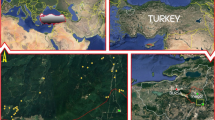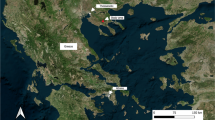Abstract
Forest regeneration on soil and on decaying wood was studied in natural mixed stand of Facus sylvatica L., Abies alba Mill. and Picea abies Karst. in Babia Góra National Park, Western Carpathians.
Downed wood, divided into five decay classes covered around 6% of the forest floor. Among seedlings, Fagus and Abies codominated, while Picea was less numerous. The average seedling density on the soil with herb layer (240 ind./100 m2) was higher than on the logs, even on the strongly decayed ones (177 ind./100 m2). However, the density of Abies and Picea seedlings was higher on the rotten wood than on soil. Seedling survival of all species was better on the logs, especially in conifers. Because of the total dominance of Fagus among saplings, the presence of Abies and Picea in the next generation of canopy trees can strongly depend upon their regeneration on decaying wood.
Similar content being viewed by others
References
Anderson, L. I. & Hytteborn, H. 1991. Bryophytes and ecaying wood—a comparison between managed and natural forests. Holarctic Ecology 14: 121–130.
Collins, S. L. 1989. Habitat relationships and survivorship of tree seedlings in hemlock-hardwood forest. Canadian Journal of Botany 68: 790–797.
Dziewolski, J. 1980. The changes in the structure and resources of the forest of the strict reserve in the Trzy Korony massif of the Pieniny Mountain Range in the period 1936–1972 (in Polish). Ochrona Przyrody 43: 129–156.
Facelli, J. M. & Pickett, S. T. A. 1991. Plant litter: Its dynamics and effects on plant community structure. Botanical Review 57: 1–32.
Faliński, J. B. 1986. Vegetation dynamics in temperate lowland primeval forests. Dr. W. Junk Publishers, Dordrecht.
Harmon, M. E. 1987. The influence of litter and humus accumulation and canopy openness on Picea sitchensis (Bong.) Carr. and Tsuga heterophylla (Raf.) Sarg. seedlings growing on logs. Canadian Journal of Forest Research 17: 1475–1479.
Harmon, M. E. & Franklin, J. F. 1989. Tree seedlings on logs in Picea-Tsuga forests of Oregon and Washington. Ecology 70: 48–59.
Harper, J. L. 1977. The population biology of plants. Academic Press, London.
Hofgaard, A. 1993. Structure and regeneration patterns in a virgin Picea abies forest in northern Sweden. Journal of Vegetation Science 4: 601–608.
Hytteborn, H., Packham, J. R. & Verwijst, T. 1987. Tree population dynamics, stand structure and species composition in the montane virgin forest of Vallibacken, northern Sweden. Vegetatio 72: 3–19.
Knapp, A. K. & Smith, W. K. 1982. Factors influencing understory seedling establishment of Engelman spruce (Picea engelmanii) and subalpine fir (Abies lasiocarpa) in southeast Wyoming. Canadian Journal of Botany 60: 2753–2761.
Koop, H. 1989. Forest Dynamics. SILVI-STAR: A comprehensive minitoring system. Springer Verlag, Berlin-Heidelberg.
Korpel, S. 1989. Pralesy Slovenska, Veda, Bratislava.
Maser, C., Tarrant, R. F., Trappe, J. M. & Franklin, J. F. 1988. From the forest to the sea: A story of fallen trees. General Technical Report PNW-GTR-229, USDA Forest Service, Portland, Oregon.
Mayer, H., Schenker, S. & Zukrigl, K. 1972. Der Urwaldrest Neuwald beim Lahnsattel. Centralblatt fur das gesamte Forstwesen 89: 147–190.
Nakamura, T. 1987. Bryophyte and lichen succession on fallen logs and seedling establishment in Tsuga-Abies forests of central Japan. Symposia Biologica Hungarica 35: 485–495.
Nakashizuka, T. 1989. Role of uprooting in composition and dynamics of an old-growth forest in Japan. Ecology 70: 1273–1278.
Rauh, J. & Schmitt, M. 1991. Methodik und Ergebnisse der Totholzforschung in Naturwaldreservaten. Forstwissenschaftliches Centralblatt. 110: 114–127.
Rutkowski, B. 1992. Changes in species composition of the forest stands in Krynica Experimental Forest (in Polish). Sylwan 136: 61–70.
Schaetzl, R. J., Burns, S. F., Johnson, D. L. & Small, T. W. 1989. Tree uprooting: review of impacts on forests ecology. Vegetatio 79: 165–176.
Sokal, R. R. & Rohlf, F. J. 1981. Biometry. W. H. Freeman and Co., New York.
Streng, D. R., Glitzenstein, J. S. & Harcombe, P. A. 1989. Woody seedlings dynamics in an East Texas floodplain forest. Ecological Monographs 59: 177–204.
Szewczyk, J. 1993. Development of the beech, fir and spruce regeneration on various substrates related to the tree stand composition in Zarnówka reserve (in Polish). Unpublished MSc Thesis, Agricultural University in Kraków, 77 pp.
Szwagrzyk, J., Bodziarczyk, J. & Szewczyk, J. Species composition and structure of old-growth tree stand in Babia Góra National Park. Folia Forestalia Polonica (in print).
Webb, S. L. 1988. Windstorm damage and microsite colonization in two Minnesota forest. Canadian Journal of Forest Research 18: 1186–1195.
Zukrigl, K. 1983. Naturwaldreservate in Oesterreich. Oekologie Linz 5(2): 20–27.
Author information
Authors and Affiliations
Rights and permissions
About this article
Cite this article
Szewczyk, J., Szwagrzyk, J. Tree regeneration on rotten wood and on soil in old-growth stand. Vegetatio 122, 37–46 (1996). https://doi.org/10.1007/BF00052814
Accepted:
Issue Date:
DOI: https://doi.org/10.1007/BF00052814




